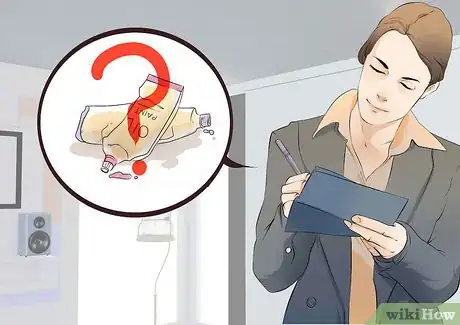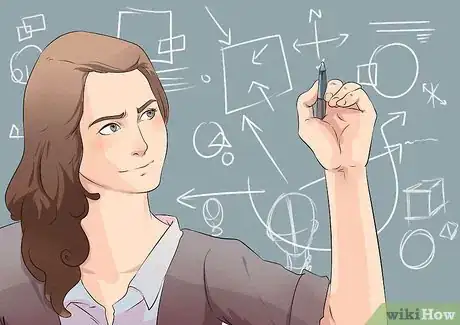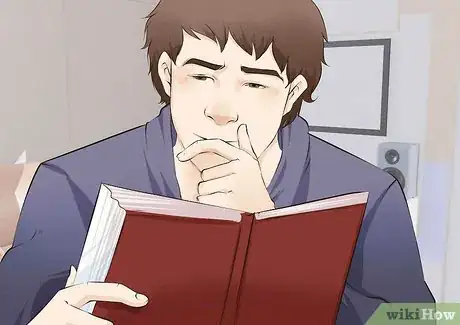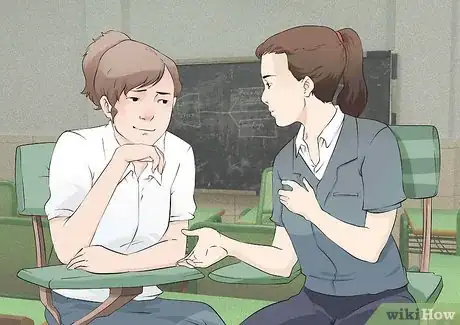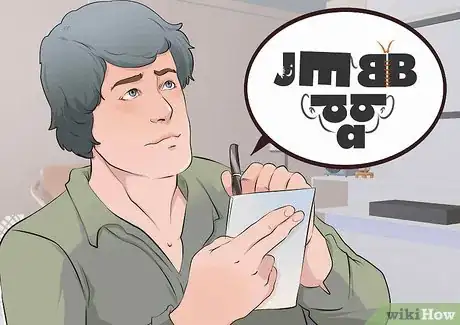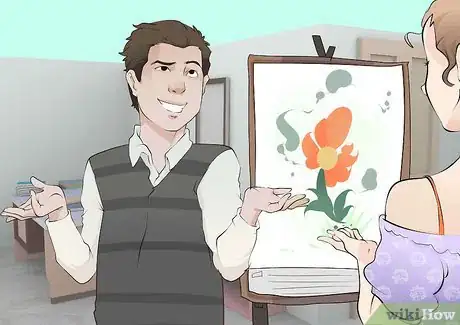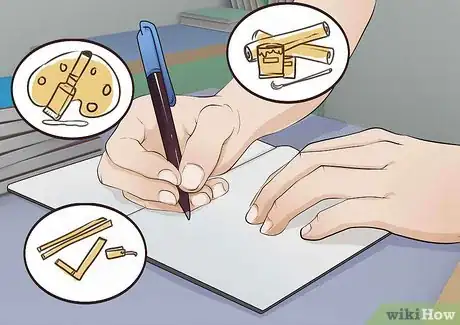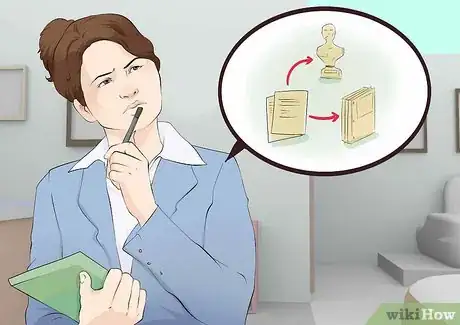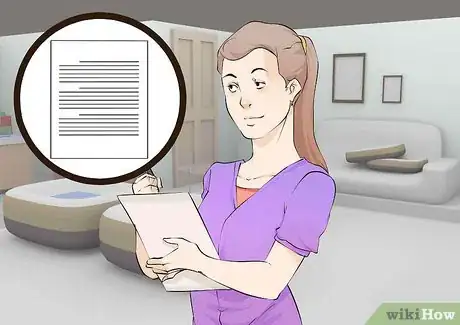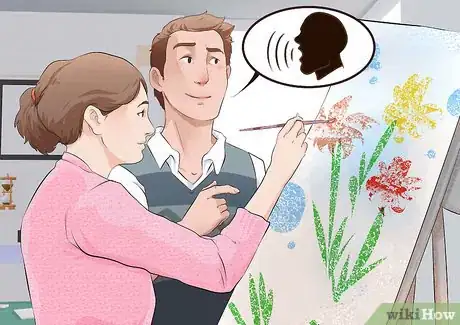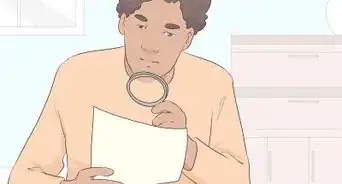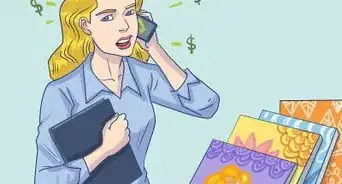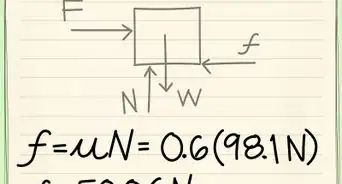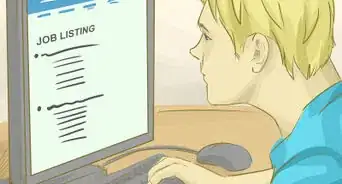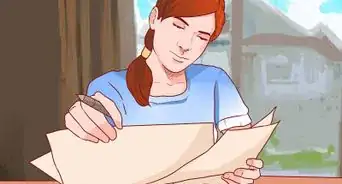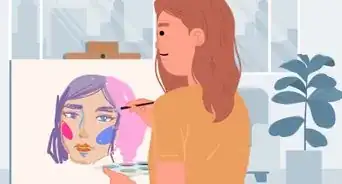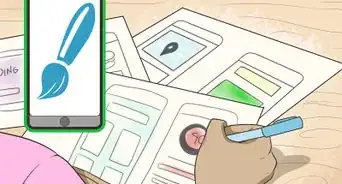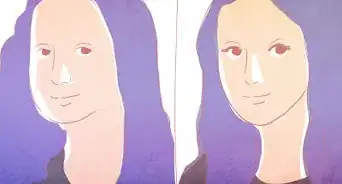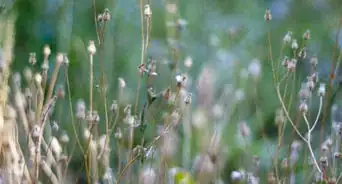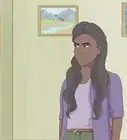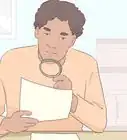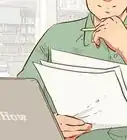This article was co-authored by Veronica Winters. Veronica Winters is a Figurative Artist who owns an online art gallery and studio in Naples, Florida. With over 20 years of experience, Veronica specializes in surreal figurative oil paintings and colored pencil drawings. In 2022, she won the Award for Distinction at the 30th Annual Colored Pencil Society of America International Exhibition. Veronica is also a published author of two art books: How to Color Like an Artist and The Colored Pencil Manual. She received her BFA in Studio Art at Oklahoma State University and her MFA in Painting at Pennsylvania State University. Veronica also studied classical drawing at the Grand Central Academy of Art and the Art Students League of New York.
This article has been viewed 19,308 times.
It is quite hard to write a really good artist statement, even if you're a good writer. The statement accompanies a piece or set of work you've painted, drawn, photographed, created, and it must sum up such elements as motivation, description and backstory. Ultimately, if you can use the appropriate words to convey the meaning of the art from your perspective, it will add another layer of meaning for the viewer to learn from.
Steps
Brainstorming Your Statement
-
1Ask yourself some questions. Before you can write your statement, you should ask yourself some important questions. Your statement is your chance to discuss your art process, your ideas, and how your art fits in the field. Be honest with yourself as you answer these questions:[1]
- What are my influences (e.g. personal, historical, theoretical, cultural)?
- What themes, ideas, and subjects are in my art?
- What do I do?
- How do I do it?
- Why do I it?
- What do I want other people to understand about my art?
- Is there anything about my art that I do not want to discuss? Why?
-
2Write down your ideas. Set a timer for 15 minutes and write down your responses to these questions. If your responses lead you down another path, write about those things as well. This exercise helps you move your ideas from your head to a piece of paper. You can incorporate drawings into this writing process as well.
- It may be helpful to target your writing to one specific question instead of trying to answer multiple questions. For example, you may choose to write about why you use oil to paint.
- You can also write on multiple pieces of art paper instead of a notebook so that you can rearrange your ideas and make them more visual.
Advertisement -
3Mind-map your ideas. A mind map is a visual diagram that lets you connect information to once central idea. Think of it as an idea tree.[2] Write the answer to one of your questions in the middle of the page. The you can use arrows or dotted lines for all of the answers to your questions.[3]
- All of the arrows and/or dotted lines do not have to connect to the center of the diagram. Some of them may connect to each other.
- You can also use pictures or drawings to communicate your thoughts and answers.
-
4Read some examples. Reading examples of good and poorly written artist's statements can help you craft your statement. Pay special attention to artists whose work is similar to yours and artists that you admire. You may want to read examples after you have finished brainstorming. This will help you format your ideas without being influenced by others.
- Check out books, exhibition catalogs, and periodicals to find examples. If you are in school, ask your teacher for examples or talk to a librarian.
- Take note of the phrasing that people use to describe their work.
-
5Talk to your friends. It can be hard to write about your art. Display your art and invite some of your friends over. Video and/or audio record the conversation so you can listen to it later. You should also take notes during the discussion.
- Pay special attention to any questions and critiques about your work. These things are often what people really want to know about your work.
- Consider discussing your work with both artists and non-artists. This will allow you to see your art from multiple perspectives.
- Another option is to have a friend interview you about your work.
Writing the Key Components
-
1Create an image with your words. Your artist's statement should stand on its own. Someone should be able to read your statement and imagine what your work looks like. Create a list of words and phrases that describe your work, your process, and your influences. Once you have created your list, edit down your list to the items that most reflect your work and who you are as an artist.
- Create sentences using the words and phrases that you have identified. You can combine and arrange your sentences until they flow in a logical order.
- You may need to repeat this process multiple times until you are satisfied with the outcome.
- Also think about the time and space that you would like the reader to view your work.
-
2Describe what kind of art you make. This section of your statement is where you write exactly what you make. Let your readers know what your project is. Include information about why you are interested in this type of work and any themes that may be found in your work.
- You can describe your art in any way that you choose. Just remember that you must support your description with the how and why you make the art.[4]
-
3Write the methods you used to make your art. Once you describe the art you make, describe the methods you use to make the art. What materials (e.g. paint, wood, paper, etc.) do you use? What tools (e.g. brush, hands, etc.) did you use? Do you paint on the floor or do you use an easel? Do you always listen to music when you work? What techniques do you use?[5]
- You do not have to write down every single step of the process that was used to create the work. Note the things that are most important.
- If you do something particularly unusual during your process, include that in your statement.
-
4Write down why you make your art. Your motivation and purpose for creating art provides a context for people that view your art. It also helps people understand your point of view as an artist. Is your art commentary on current events or social circumstances? Are you trying to draw connections between different concepts?[6] Are you using your art to tell a story? What does your art mean to you?
- Focus on your story and why you create art. Talk about emotions and what you want to communicate with your artwork.
- If your motivations changed while you were working on the project, let the audience know that is well.
- Maybe you were influenced by a trip you took, a book you read, a movie, or a family member. All of these things help the audience get a better understanding of you and your work.
- For example, if you wanted your art discussed within the context of feminism, you should clearly outline that in this part of your statement.[7]
-
5Use clear concise language. Your statement should be easy to understand. Do not include any language that is too specific to the art world. Also avoid using complicated, complex words. Your statement should sound genuine and real.
- Your statement should add information that can not be gathered from looking at your art. Do not use the statement to simply describe what the audience can see with their own eyes.[8]
- Try not to use a quote from another artists or philosopher. If you do use a quote, do not use more than one and keep it short. Also be sure that you have correctly interpreted the quote.
- Avoid phrases such as "I am trying to," "I am hoping to," and "I would like to."[9] Just state what you have done.
- Be as objective as possible. Your statement should not be used to promote your art or "talk it up."[10] Let your audience interpret your work on their own.
Structuring Your Statement
-
1Determine where your statement will be used. You may need to modify your statement based on where your statement will be used. If you artist statement is for a particular piece or project, your statement should be tailored to that specific piece. If you artist statement is part of your portfolio, it should be a broader description.
-
2Edit to one page or less. Artist statements are usually 25 words, one or two paragraphs, or one page. One page statements are used to describe your whole body of work or to accompany an exhibition, or as part of a grant application. One or two paragraph statements are usually for a specific piece of work. The 25 word statement is to describe the central idea of your work.[13]
- Memorize your 25 word statement. This should be your response when people ask you what you do.
- Your one page statement can also be given to publicists, writers, and gallery owners when they need a description of your work.
-
3Proofread your statement. Check your grammar and vocabulary. Make sure that there are no confusing ideas and your statement is written in a logical order.[14] You may need to rearrange sentences and phrases to improve the flow of your statement.
- You will need multiple rewrites and edits before you have a quality statement.
- Your statement should only include essential information.
-
4Get feedback on your statement. Get feedback on your statement from artists and non-artists. Your statement will likely be viewed by people from all backgrounds. It should be clear to anyone who reads it. Do not wait until you are finished with your statement before you ask for feedback. Have someone look at your rough drafts as well.
- In addition to getting feedback on your statement, also get feedback on the connection between your statement and your actual art. [15]
- The average art viewer will spend 5 to 15 seconds looking at your work. Your statement should be clear enough to convey a message in a very short amount of time.
Expert Q&A
-
QuestionHow do you write an amazing artist statement?
 Veronica WintersVeronica Winters is a Figurative Artist who owns an online art gallery and studio in Naples, Florida. With over 20 years of experience, Veronica specializes in surreal figurative oil paintings and colored pencil drawings. In 2022, she won the Award for Distinction at the 30th Annual Colored Pencil Society of America International Exhibition. Veronica is also a published author of two art books: How to Color Like an Artist and The Colored Pencil Manual. She received her BFA in Studio Art at Oklahoma State University and her MFA in Painting at Pennsylvania State University. Veronica also studied classical drawing at the Grand Central Academy of Art and the Art Students League of New York.
Veronica WintersVeronica Winters is a Figurative Artist who owns an online art gallery and studio in Naples, Florida. With over 20 years of experience, Veronica specializes in surreal figurative oil paintings and colored pencil drawings. In 2022, she won the Award for Distinction at the 30th Annual Colored Pencil Society of America International Exhibition. Veronica is also a published author of two art books: How to Color Like an Artist and The Colored Pencil Manual. She received her BFA in Studio Art at Oklahoma State University and her MFA in Painting at Pennsylvania State University. Veronica also studied classical drawing at the Grand Central Academy of Art and the Art Students League of New York.
Figurative Artist Although you can include materials and techniques in your statement, know that the most important element is to explain the meaning and the symbols of the work. If you're not sure about it, know that you're not alone. Sometimes I begin painting without knowing what my image is about. By the time you finish it, you'll probably understand what you have held deep inside yourself that came out in the form of figures and symbols. Reach inside to really understand your piece!
Although you can include materials and techniques in your statement, know that the most important element is to explain the meaning and the symbols of the work. If you're not sure about it, know that you're not alone. Sometimes I begin painting without knowing what my image is about. By the time you finish it, you'll probably understand what you have held deep inside yourself that came out in the form of figures and symbols. Reach inside to really understand your piece!
References
- ↑ http://www.cgu.edu/pages/7483.asp
- ↑ http://lifehacker.com/how-to-use-mind-maps-to-unleash-your-brains-creativity-1348869811
- ↑ http://www.cgu.edu/pages/7483.asp
- ↑ http://www.cgu.edu/pages/7483.asp
- ↑ http://www.cgu.edu/pages/7483.asp
- ↑ http://www.cgu.edu/pages/7483.asp
- ↑ http://www.cgu.edu/pages/7483.asp
- ↑ http://www.artspartner.org/files/all/artists_statement_bio_info.pdf
- ↑ http://www.artspartner.org/files/all/artists_statement_bio_info.pdf
- ↑ https://www.artquest.org.uk/how-to-articles/artist-statement/
- ↑ http://www.artspartner.org/files/all/artists_statement_bio_info.pdf
- ↑ http://grantspace.org/tools/knowledge-base/Individual-Grantseekers/Artists/artist-s-statements
- ↑ http://www.artspartner.org/files/all/artists_statement_bio_info.pdf
- ↑ http://www.artspartner.org/files/all/artists_statement_bio_info.pdf
- ↑ http://www.cgu.edu/pages/7483.asp
About This Article
To write an artist's statement, start by describing what kind of art you make. Next, explain the methods and tools you use in your work. Then, get into your motivations and the purpose behind your creations. You could talk about the connections you're trying to draw between concepts, name specific influences, or explain what the art means to you on a personal level. Use clear language, be concise, and write as straightforwardly as possible to create a genuine tone. For tips on editing and revising your statement, read on!

